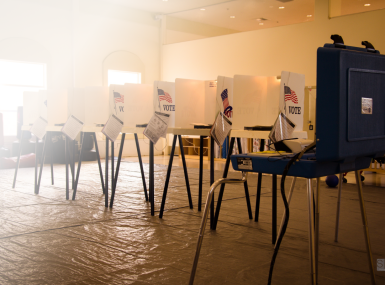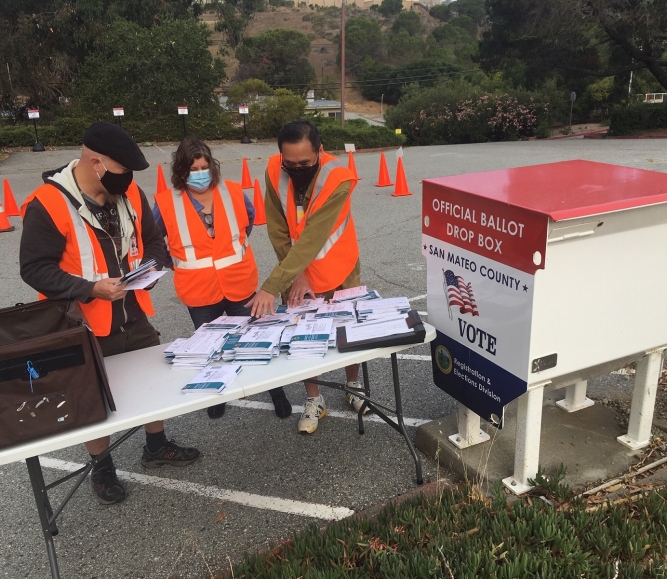Change remains a constant for county elections operations

The Nov. 5, 2024 presidential election looms large, with plenty to consider: What will voter turnout look like? Will election administrators have enough workers? Will security be a concern?
Local election administration has always been something of a patchwork quilt across the country. That’s no different even within some states.
In Davis County, Utah, County Clerk Brian McKenzie runs the elections. In most of the counties there, it’s a duty of the person whose job holds the dual title of clerk/auditor. But in Utah, a state law allows county boards to decide if they want to change that, splitting the county clerk/auditor position into two jobs. That’s what Davis County decided to do beginning in 2022.
All about elections
County governments oversee most local, state, and federal elections at the local level, including voter registration, managing polling places, and coordinating poll workers.
In each election cycle, counties oversee over 100,000 polling places staffed with over 630,000 poll workers.
In 2022, more than 201 million people were registered and eligible to vote in jurisdictions where counties play a significant role in election administration.
“As they talked about this in their meetings, they were looking at the complexity of both of those jobs — they are both very demanding,” McKenzie said, noting that clerks also handle many other duties in addition to elections.
“It’s difficult for a county our size [more than 367,000 as of the 2021 Census] to manage those duties and dedicate the resources needed. They took into account the size of the county, the demands, the expertise that’s needed and you’re looking at that and looking for someone to serve as chief financial officer, looking for a GFOA or CPA or something like that [for the auditor portion of the job] and that doesn’t always equate to someone knowledgeable about elections.”
“Elections have definitely advanced in sophistication, technology and legislative requirements,” said McKenzie, who has worked in election administration and seen those changes over the past 18 years.
Appointed county administrator vs. elected county clerk
In Texas, a new state law takes away an appointed election administrator position in any county with a population of 3.5 million or more. The only county that is impacted by that is Harris County, which appointed its first election administrator in 2020.
Those who back the new law point to what they say was mismanagement (citing long wait times and ballot paper shortages) of a 2022 election by a newly appointed election administrator. Since the new law went into effect last fall, the elected County Clerk Tenesia Hudspeth will administer elections and elected tax Assessor-Collector Ann Harris Bennett will handle voter registration.
“The public needs to know that there is a chief election official for the county who is committed to conducting the elections with a nonpartisan spirit and in accordance with the law to enable all voters equal access to the voting process,” Hudspeth said in a statement to Votebeat.
In Cascade County, Mont., a newcomer to election administration won an election by 40 votes, ousting someone with 16 years of experience. After problems arose with elections under the new county clerk, the Board of Commissioners took advantage of a state law that allows them to appoint an election administrator.
“The law here in Montana says the clerk and recorder will be the elections administrator unless the local governing body decides differently,” said Cascade County Commissioner Jim Larson. “I voted to overturn it.”
Larson said he hopes they will have some interviews for the new elections administrator position “done by the end of this month.”
His advice to other counties facing an issue with someone in the job who is inexperienced: “If I’d let this go, it never would have healed itself. We had to cut the cord here and go to work on this whole thing. It’ll calm down.”
“If I had to tell somebody else, if they feel uncomfortable with their current situation and they have a statute like we do, where they can take it, if you have a feeling like that, you should probably do it sooner rather than later.”
Vote-by-mail
In “mostly mail” elections, all registered voters are sent a ballot in the mail. The voter marks the ballot, puts it in a secrecy envelope or sleeve and then into a separate mailing envelope, signs an affidavit on the exterior of the mailing envelope and returns the package via mail or by dropping it off, the National Conference of State Legislatures (NCSL) points out.
Ballots are mailed out well ahead of Election Day, and thus voters have an “election period,” not just a single day, to vote. Mostly mail elections can be thought of as absentee voting for everyone, according to NCSL. This system is also referred to as “vote by mail.” Here’s a look at the vote-by-mail landscape:
Eight states — California, Colorado, Hawaii, Nevada, Oregon, Utah, Vermont and Washington and the District of Columbia — allow all elections to be conducted entirely by mail.
Two states — Nebraska and North Dakota — permit counties to opt into conducting elections by mail.
Nine states — Alaska, Arizona, Florida, Kansas, Maryland, Missouri, Montana, New Mexico and Wyoming — allow specific small elections to be conducted by mail.
Four states — Idaho, Minnesota, New Jersey and New Mexico — permit mostly-mail elections for certain small jurisdictions.
It’s a formula that’s worked well in McKenzie’s county, where they’re celebrating the 10-year anniversary of vote by mail this year.
“Folks out there think 2020 was the year we switched out,” he said. “We’re excited about that, what we’ve been able to accomplish.”
Over those 10 years, the county has seen an increase in turnout for municipal elections.
“Pre-mail, we were thrilled with anything over 10%. Now, it’s 30 to 50%. That’s a good thing, right?” he said. “More people are getting involved, the people getting elected more appropriately represent the people they’re serving.”
Although Davis County is the smallest county geographically in Utah, it counts 194,000 active registered voters. McKenzie notes that the county maintains a 99.9% accurate voter database. “It’s the cleanest in the history of our state,” he said.
“Here in our county, voters have all the options,” McKenzie said. “We’re small geographically, you can drive from one end to the other in half-an-hour. We have 15 vote centers, 16 drop boxes, we pay return postage on vote-by-mail ballots. The best person to decide how to cast their vote is the voter.”
Of the 194,000 active registered voters, 95 to 98 percent take advantage of the vote-by-mail option, McKenzie said. “We do not have long lines at all. That to me is a measure of success, it works for them.”
Recruitment
Although some election administrators have a tough time getting enough poll workers to help on Election Day, in Davis County, they use an online application process that is “there all the time,” McKenzie noted. “A lot of it is word of mouth,” with people who have worked on past elections, telling friends and family about their experience, he said. “And so we bring in those folks as well.”
New: Election observation area
New this year in Davis County is an election observation area. “We’re just about finished with our new election observation area, bringing people right up close to everything we’re doing, within 6 feet or less when we’re handling ballots,” he said.
“Security has always been a top priority for us,” he said. “We have some legislative things that have come through that have enhanced security, such as video surveillance. We have a new observation area, and enhanced security for that as well. We revise our plans, especially after the things that have happened with suspicious mail delivered to our colleagues around the country in November. We have continuity plans, so we can make sure we are keeping people safe.”
“We think that’s really, really important, making sure they are accessible, transparent and secure.”
Related News

County Countdown – April 7, 2025
Every other week, NACo's County Countdown reviews top federal policy advocacy items with an eye towards counties and the intergovernmental partnership. This week features a budget reconciliation update, HHS restructuring and more.

Both the Administration and Congress act on 'noncitizen voting:' What this could mean for counties
The U.S. House will consider the Safeguard American Voter Eligibility (SAVE) Act this week to require individuals to provide proof of citizenship to register to vote.

Multi-State Information Sharing and Analysis Center (MS-ISAC) loses federal funding
On March 11, the Cybersecurity and Infrastructure Security Agency (CISA) announced a $10 million cut in funding for the Multi-State Information Sharing and Analysis Center (MS-ISAC), which provides critical local assistance for cybersecurity threat detection and analysis resources and support.
County News
County clerks ‘pull back the curtain’ on elections

